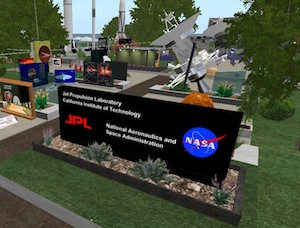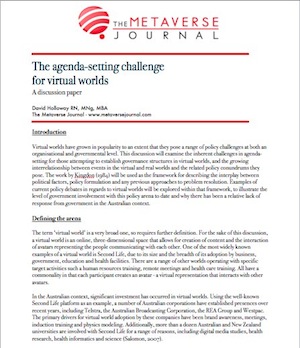 The issue of virtual worlds getting on a government’s policy agenda is something we’ve examined pretty closely, and like most of you reading this, it can get frustrating sometimes seeing the pace at which change is occurring.
The issue of virtual worlds getting on a government’s policy agenda is something we’ve examined pretty closely, and like most of you reading this, it can get frustrating sometimes seeing the pace at which change is occurring.
In recent days I was again struck on the world leadership role the United States Government are taking in regards to virtual worlds. This report by Dawn Lim at Nextgov showcases beautifully both the depth and breadth of work going on across a range of US Government departments, including the cross-agency vGov portal which is currently under development.
The contrast with Australian government departments is fairly stark. Educators and artists are certainly leading the way, but things get pretty sparse beyond that. In the e-health sphere, there is only limited awareness of the potential of virtual worlds and there’s certainly no active strategy to incorporate them into developing standards.
That said, the Government 2.0 Taskforce report commissioned by the Australian Government does hold some promise. You can read the Government’s full response to the report here, but the standout recommendation for me is 4.4, which states:
Agencies should support employee-initiated, innovative Government 2.0- based proposals that create, or support, greater engagement and participation with their customers, citizens and/or communities of interest in different aspects of the agency’s work. They should create a culture that gives their staff an opportunity to experiment and develop new opportunities for engagement from their own initiative, rewarding those especially who create new engagement/participation tools or methods that can quickly be absorbed into the mainstream practice that lifts the performance of the department or agency.
That’s the open invitation for Australian Government Departments to start innovating, and the US Government example is certainly one worth exploring for its applicability here. In that example, it was the usual story of small groups or individuals advocating for change and driving that change with minimal budget support. Government Departments here obviously don’t have the critical mass that their US counterparts do, but the very nature of virtual worlds means that’s not a significant roadblock.
The main barriers still seem to be awareness and a reliance on stereotypes to inform decision-making. Only those handful of people working within the system will be able to change that, although fighting against short-term political prerogatives isn’t easy at the best of times, let alone in the midst of a heated debate over internet filtering.
Over to you: are you aware of governmental initiatives underway that may help in shaping policy agendas in the medium term?


Recent Comments